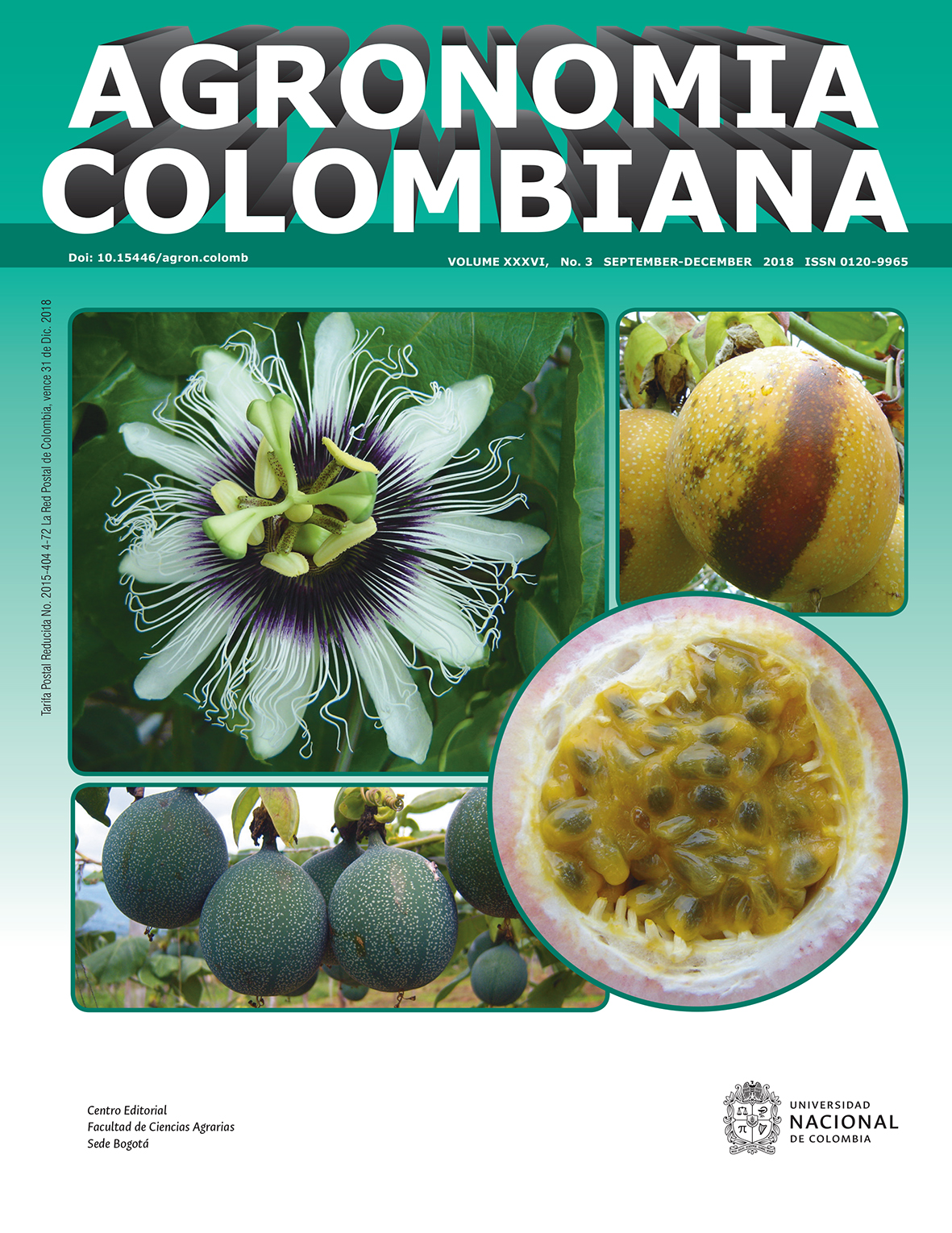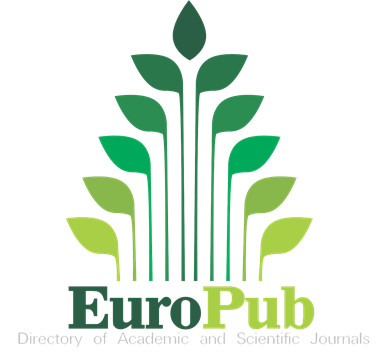Fertility recovery of anther-derived haploid plants in Cape gooseberry (Physalis peruviana L.)
Restauración de la fertilidad de plantas haploides derivadas de anteras en uchuva (Physalis peruviana L.)
DOI:
https://doi.org/10.15446/agron.colomb.v36n3.73108Keywords:
colchicine, chloroplasts, chromosomes, mixoploidy (en)colchicina, cloroplastos, cromosomas, mixoploidía (es)
Downloads
The cape gooseberry (Physalis peruviana L.) is one of the most important Colombian exotic fruits. Chromosome doubling of anther-derived plants is a key factor in the application of double haploid technology for the genetic improvement of crops. In the present study, axillary buds from four haploid cape gooseberry genotypes were used to evaluate artificial chromosome doubling induced by colchicine and its effects on ploidy level and pollen fertility. Three concentrations of colchicine (5, 10 and 15 mM) and three exposure times (2, 4 and 6 h) were used to determine the best treatment for the generation of fertileB plants from axillary buds of haploid genotypes. The colchicine increased both the number of chromosomes, from 36 to 129, and the average chloroplasts in stomata guard cell, from 4.5 to 23.8. The optimal chromosome doubling of the haploids was obtained with the 5 mM colchicine solution and 2 h exposure time. This protocol produced chromosome doubling in over 60% of the regenerants of the four haploid genotypes, with a high level of fertility. Morphologically, the fertile mixoploid plants showed variation in the vegetative, flowering and fruit characteristics, as compared to the haploid plants.
La uchuva (Physalis peruviana L.) es una de las frutas exóticas de mayor importancia para Colombia. La duplicacion cromosómica de plantas derivadas de cultivo de anteras es un factor clave en la aplicacion de la tecnologia doble haploide para el mejoramiento genetico de los cultivos. En el presente estudio, se evaluo la duplicacion cromosomica artificial inducida por colchicina en yemas axilares de cuatro genotipos haploides de uchuva y su efecto en el nivel de ploidia y la fertilidad polinica. Se emplearon tres concentraciones de colchicina (5, 10, 15 mM) y tres tiempos de exposicion (2, 4 y 6 h) con el fin de determinar el mejor tratamiento para la generacion de plantas fertiles a partir de yemas axilares de genotipos haploides. La colchicina incremento el numero de cromosomas entre 34 hasta 129 y el promedio de cloroplastos por celulas guarda entre 4.5 hasta 23.8. El doblamiento cromosomico optimo de plantas haploides se obtuvo con la solucion de colchicina 5 mM por 2 h. Este protocolo produjo doblamiento cromosomico en 60% de las plantas regeneradas obtenidas en los cuatro genotipos haploides, presentando un alto nivel de fertilidad. Morfologicamente, las plantas mixoploides fertiles presentaron variacion en caracteristicas vegetativas, de floracion y en fruto, comparado con las plantas haploides.
References
Amiri, S., S. Kazemitabaar, G. Ranjbar, and M. Azadbakht. 2010. The effect of trifluralin and colchicine treatments on morphological characteristics of Jimsonweed (Datura stramonium L.). Trakia J. Sci. 8, 47-61.
Ari, E., T. Yildirim, N. Mutlu, S. Buyukalaca, U. Gokmen, and E. Akman. 2016. Comparison of different androgenesis protocols for doubled haploid plant production in ornamental pepper (Capsicum annuum L.). Turk. J. Biol. 40, 944-954. Doi: 10.3906/biy-1509-36
Baez, P., M. Riveros, and C. Lehnebach. 2002. Viability and longevity of pollen of Nothofagus species in south Chile. New Zeal. J. Bot. 40, 671-678. Doi: 10.1080/0028825X.2002.9512822
Burun, B. and U. Emiroğlu. 2008. A comparative study on colchicine application methods in obtaining doubled haploids of tobacco (Nicotiana tabacum L.). Turk. J. Biol. 32, 105-111.
Chauvin, J., C. Souchet, J. Dantec, and D. Ellisseche. 2003. Chromosome doubling of 2x Solanum species by oryzalin: Method development and comparison with spontaneous chromosome doubling in vitro. Plant Cell Tissue Organ Cult. 73, 65-73. Doi: 10.1023/A:1022663816052
Cheniclet, C., W.Y. Rong, M. Causse, N. Frangne, L. Bolling, J.P. Carde, and J.P. Renaudin. 2005. Cell expansion and endoreduplication show a large genetic variability in pericarp and contribute strongly to tomato fruit growth. Plant Physiol. 139, 1984-1994. Doi: 10.1104/pp.105.068767
Delgado-Paredes, G., C. Rojas-Idrogo, J. Chaname-Cespedes, E. Floh, and W. Handro. 2017. Development and agronomic evaluation of in vitro somaclonal variation in sweet potato plants from direct organogenesis in roots. Asian J. Agric. Res. 7, 39-48.
Diaz, D., D. Gonzalez, L. Rache, and J. Pacheco. 2008. Efecto citogenetico de la colchicina sobre yemas vegetativas de Physalis peruviana L. Prospect. Cientif. 4, 27-40.
Edwald, D., K. Ulrich, G. Naujoks, and M. Schroder. 2009. Induction of tetraploid poplar and black locust plants using colchicine: Chloroplast number as an early marker for selecting polyploids in vitro. Plant Cell Tissue Organ Cult. 99, 353-357. Doi: 10.1007/s11240-009-9601-3
Franco, C.V. 2012. Efecto de la colchicina sobre el numero cromosomico, numero de cloroplastos y caracteristicas morfológicas del fruto en ecotipos de uchuva (Physalis peruviana L.) Colombia, Kenia y Peru. Trabajo de grado. Universidad Francisco de Paula Santander. San Jose de Cucuta, Colombia.
Grisales, N., O. Trillos, J. Cotes, and L. Orozco. 2010. Estudios de fertilidad de polen en accesiones de uchuva (Physalis peruviana L.). Rev. Fac. Ciencias Basicas 6, 42-51.
Kermani, M.J., V. Sarasan, A.V. Roberts, K. Yokoya, J. Wentworth, and V.K. Sieber. 2003. Oryzalin-induced chromosome doubling in Rosa and its effect on plant morphology and pollen viability. Theor. Appl. Genet. 107, 1195-1200. Doi: 10.1007/s00122-003-1374-1
Koornneef, M., J.A.M. Van Diepen, C.J. Hanhart, A.C.K. Waart, and L. Martinelli, 1989. Chromosomal instability in cell- and tissue cultures of tomato haploids and diploids. Euphytica 43, 179-186. Doi: 10.1007/BF00037911
Liberato, S., E. Sanchez-Betancourt, J. Arguelles, C. Gonzalez, V. Nunez, and L.S. Barrero. 2015. Cytogenetics of Physalis peruviana L., and Physalis floridana Rydb. genotypes with differential response to Fusarium oxysporum. Corpoica Cienc. Tecnol. Agropecu. 15, 51-61. Doi: 10.21930/rcta.vol15_num1_art:396
Ligarreto, G., M. Lobo, and A. Correa. 2005. Recursos geneticos del genero Physalis en Colombia. pp. 329-338. In: Fischer G., D.
Miranda, W. Piedrahita, and J. Romero (eds.). Avances en cultivo, poscosecha y exportacion de la uchuva Physalis peruviana L. en Colombia. Universidad Nacional de Colombia, Bogota.
Murashige, T. and R. Nakano. 1966. Tissue culture as a potential tool in obtaining polyploid plants. J. Hered. 57, 115. Doi: 10.1093/oxfordjournals.jhered.a107486
Murashige, T. and F. Skoog. 1962. A revised medium for rapid growth and bio assays with tobacco tissue cultures. Physiol. Plant. 15, 473-497. Doi: 10.1111/j.1399-3054.1962.tb08052.x
Murovec, J. and B. Bohanec. 2012. Haploids and doubled haploids in plant breeding. pp. 87-106. In: Abdurakhmonov, I. (ed.). Plant Breeding. IntechOpen, Rijeka, Croatia, Doi: 10.5772/29982
Nattaporn, K. and T. Sompong. 2012. Effects of Colchicine on survival rate, morphological, physiological and cytological characters of Chang Daeng orchid (Rhynchostylis gigantean var. rubrum Sagarik) In Vitro. J. Agric. Technol. 8, 1451-1460.
Novakova, L., K. Kovacovicova, and T.Q. Dang-Nguyen. 2016. A Balance between nuclear and cytoplasmic volumes controls spindle length. PLoS One 1-11. Doi: 10.1371/journal.pone.0149535
Ojiewo, C., S. Agong, K. Murakami, and M. Masuda. 2006. Chromosome duplication and ploidy level determination in African nightshade Solanum villosum Miller. J. Hortic. Sci. Biotechnol. 81, 183 188. Doi: 10.1080/14620316.2006.11512048
Olmstead, R.G. 2013. Phylogeny and biogeography in Solanaceae, Verbenaceae and Bignoniaceae: A comparison of continental and intercontinental diversification patterns. Bot. J. 80-102. Doi:10.1111/j.1095-8339.2012.01306.x
Patino, D., E. Garcia, E. Barrera, O. Quejada, H.D. Rodriguez, and I. Arroyave. 2014. Manual tecnico uchuva bajo buenas practicas agricolas. SENA, Medellin, Colombia.
Qin, X. and L. Rotino. 1995. Chloroplast number in guard cells as ploidy indicator of in vitro-grown androgenic pepper BF00051583
Rodriguez, N. and M. Bueno. 2006. Study of the cytogenetic diversity of Physalis peruviana L. (Solanaceae). Acta Biol. Colomb. 11, 75-85.
Sanchez, E. 2014. Nivel de ploidia de plantas de uchuva provenientes de cultivo de anteras. MSc thesis. Universidad Nacional de Colombia. Bogota.
Sari, N., K. Abak, and M. Pitrat. 1999. Comparison of ploidy level screening methods in watermelon: Citrullus lanatus (Thunb.) Matsum. and Nakai. Sci. Hortic. 82, 265-277. Doi: 10.1016/S0304-4238(99)00077-1
Segui-Simarro, J.M. and F. Nuez. 2008. Pathways to doubled haploidy: Chromosome doubling during androgenesis. Cytogenet. Genome Res. 120, 358-369. Doi: 10.1159/000121085
Shao, J., C. Chen, and X. Deng. 2003. In vitro induction of tetraploid in pomegranate (Punica granatum). Plant Cell Tissue Organ Cult. 75, 241-246. Doi: 10.1023/A:1025871810813
Smykalova, I., M. Větrovcova, M. Klima, I. Machačkova, and M. Griga. 2006. Efficiency of microspore culture for doubled haploid production in the breeding project “Czech Winter Rape.” Czech J. Genet. Plant Breed. 42, 58-71. Doi: 10.17221/3655-CJGPB
Suescun, L., E. Sanchez, M. Gomez, F.L. Garcia-Arias, and V.M. Nunez Zarantes. 2011. Produccion de plantas genéticamente puras de Uchuva. Editorial Kimpres Ltda., Bogota.
Weber, S., F. Unker, and W. Friedt. 2005. Improved doubled haploid production protocol for Brassica napus using microspore colchicine treatment in vitro and ploidy determination by flow cytometry. Plant Breed. 124, 511-513. Doi: 10.1111/j.1439-0523.2005.01114.x
Wenzel, W. 1973. A cytological study of colchiploid cape gooseberry (Physalis peruviana L.). Agroplantae 5, 79-84.
Wu, S., J.Y. Tsai, S.P. Chang, D.L. Lin, S.S. Wang, S.N. Huang, and L.T. Ng. (2006). Supercritical carbon dioxide extract exhibits enhanced antioxidant and anti-inflammatory activities of Physalis peruviana. J. Ethnopharmacol. 108, 407-413. Doi: 10.1016/j.jep.2006.05.027
Zamani, I., E. Gouli-Vavdinoudi, G. Kovacs, I. Xynias, D. Roupakias, and B. Barnabas. 2003. Effect of parental genotypes and colchicine treatment on the androgenic response of wheat F1 hybrids. Plant Breed. 122, 314-317. Doi: 10.1046/j.1439-0523.2003.00866.x
How to Cite
APA
ACM
ACS
ABNT
Chicago
Harvard
IEEE
MLA
Turabian
Vancouver
Download Citation
CrossRef Cited-by
1. Mariana Carvalho Chaves Figueiredo, Adriana Rodrigues Passos, Frederic Mendes Hughes, Keylla Souza dos Santos, Alismário Leite da Silva, Taliane Leila Soares. (2020). Reproductive biology of Physalis angulata L. (Solanaceae). Scientia Horticulturae, 267, p.109307. https://doi.org/10.1016/j.scienta.2020.109307.
2. Edgar García-Fortea, Ana García-Pérez, Esther Gimeno-Páez, Alfredo Sánchez-Gimeno, Santiago Vilanova, Jaime Prohens, David Pastor-Calle. (2020). A Deep Learning-Based System (Microscan) for the Identification of Pollen Development Stages and Its Application to Obtaining Doubled Haploid Lines in Eggplant. Biology, 9(9), p.272. https://doi.org/10.3390/biology9090272.
3. Gerardo Mállap-Detquizán, Jegnes B. Meléndez-Mori, Eyner Huaman-Huaman, Nuri C. Vilca-Valqui, Manuel Oliva. (2022). Cultivo de anteras en Physalis peruviana L. estadios de microsporas, métodos de esterilización y medios de cultivo. Bioagro, 35(1), p.33. https://doi.org/10.51372/bioagro351.4.
4. Maria Fomicheva, Elena Kozar, Elena Domblides. (2025). Carrot (Daucus carota L.) Haploid Embryo Genome Doubling with Colchicine and Trifluralin. Horticulturae, 11(5), p.505. https://doi.org/10.3390/horticulturae11050505.
5. Luz Stella Barrero, Erika P. Sanchez-Betancourt, Gina A. Garzón-Martinez, Francy L. García-Arias, Jaime A. Osorio-Guarin, Victor M. Nuñez-Zarantes, Felix E. Enciso-Rodríguez. (2024). Handbook of Goldenberry (Physalis Peruviana). , p.39. https://doi.org/10.1016/B978-0-443-15433-1.00004-2.
6. Behzad Ahmadi, Hamed Ebrahimzadeh. (2020). In vitro androgenesis: spontaneous vs. artificial genome doubling and characterization of regenerants. Plant Cell Reports, 39(3), p.299. https://doi.org/10.1007/s00299-020-02509-z.
7. Chaitanya Ghalagi, Malavalli Rajashekar Namratha, Kavita Kotyal, Shiva Prakash, Basavaiah Mohan Raju. (2023). A novel visual marker to distinguish haploids from doubled haploids in rice (Oryza sativa, L) at early growth stages. Plant Methods, 19(1) https://doi.org/10.1186/s13007-023-01085-z.
8. E. A. Domblides, A. S. Ermolaev, S. N. Belov. (2021). Obtaining doubled haploids of Cucurbita pepo L.. Vegetable crops of Russia, (4), p.11. https://doi.org/10.18619/2072-9146-2021-4-11-26.
9. Jose M. Seguí-Simarro, Javier Belinchón Moreno, Marina Guillot Fernández, Ricardo Mir. (2021). Doubled Haploid Technology. Methods in Molecular Biology. 2287, p.41. https://doi.org/10.1007/978-1-0716-1315-3_3.
Dimensions
PlumX
Article abstract page views
Downloads
License
Copyright (c) 2018 Agronomía Colombiana

This work is licensed under a Creative Commons Attribution-NonCommercial-ShareAlike 4.0 International License.
© Centro Editorial de la Facultad de Ciencias Agrarias, Universidad Nacional de Colombia
Reproduction and quotation of material appearing in the journal is authorized provided the following are explicitly indicated: journal name, author(s) name, year, volume, issue and pages of the source. The ideas and observations recorded by the authors are their own and do not necessarily represent the views and policies of the Universidad Nacional de Colombia. Mention of products or commercial firms in the journal does not constitute a recommendation or endorsement on the part of the Universidad Nacional de Colombia; furthermore, the use of such products should comply with the product label recommendations.
The Creative Commons license used by Agronomia Colombiana journal is: Attribution - NonCommercial - ShareAlike (by-nc-sa)

Agronomia Colombiana by Centro Editorial of Facultad de Ciencias Agrarias, Universidad Nacional de Colombia is licensed under a Creative Commons Reconocimiento-NoComercial-CompartirIgual 4.0 Internacional License.
Creado a partir de la obra en http://revistas.unal.edu.co/index.php/agrocol/.




















